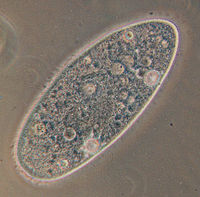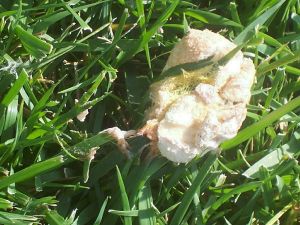Protist
| Protists | ||||
|---|---|---|---|---|
 Paramecium aurelia]], a ciliate | ||||
| Scientific classification | ||||
| ||||
| Typical phyla | ||||
|
Protosts make up one of the kingdoms into which biologists divide living things. They are more complex than bacteria in that they have cell nuclei, but less complex than fungi, plants, and animals because they are mostly single-celled or if multi-celled they lack highly specialized tissues.
Protists play important roles in the earth's ecosystems.
Traditional classification
Protists were traditionally (for the last 150 years) subdivided into several groups based on similarities to the higher kingdoms: the plant-like algae, the animal-like protozoa, and the fungi-like slime molds and water molds. These groups often overlap, and have been replaced by phylogenetic classifications. However, they are still useful as informal groups for describing the morphology and ecology of protists.
Algae
Algae gather light energy through photosynthesis. They include many single-celled creatures that are also considered protozoa, such as Euglena, which have acquired chloroplasts through secondary endosymbiosis. Others are non-motile, and some (called seaweeds) are truly multicellular, including members of the following groups:
| Chlorophytes | green algae, related to higher plants | e.g., Ulva |
| Rhodophytes | red algae | e.g., Porphyra |
| Heterokontophytes | brown algae, diatoms, etc. | e.g., Macrocystis |
The green and red algae, along with a small group called the glaucophytes, appear to be close relatives of other plants, and so some authors treat them as Plantae despite their simple organization. Most other types of algae, however, developed separately. They include the haptophytes, cryptomonads, dinoflagellates, euglenids, and chlorarachniophytes, all of which have also been considered protozoans. Some protozoa host endosymbiotic algae, as in Paramecium bursaria or radiolarians, that provide them with energy but are not integrated into the cell.
Algae are found in many environments both in water and on land. They are most important as, along with cyanobacteria, a part of the phytoplankton in the world's oceans which is the basis of almost all marine life.
Some algae exist in symbiotic relationships with other organisms. Lichens are a partnership of fungi and algae. Some corals, sponges, and jellyfish host algae which provide them with food and in return receive protection. Agae also live in the hair of sloths in South American rain forests. This relationship provides the algae with a home and the sloth with a green color for camouflage.
Seaweeds are multi-cellular algae. Although they can grow very large they lack the complex structure of plants. The largest seaweed (and the largest protist) is the giant kelp, Macrocystis pyrifera, found along the Pacific coast of North and South America. It can grow to a length of 60 meters (200 feet).
Protozoa
Protozoa are mostly single-celled, motile (can move around) protists that feed by phagocytosis, though there are numerous exceptions. They are usually only 0.01-0.5 mm in size, generally too small to be seen without a microscope. Protozoa are ubiquitous throughout aqueous environments and the soil, commonly surviving dry periods as cysts or spores, and include several important parasites. Based on locomotion, protozoa are grouped into:
| Amoeboids | with transient pseudopodia | e.g., Amoeba |
| Ciliates | with multiple, short cilia | e.g., Paramecium |
| Sporozoa | non-motile parasites; form spores | e.g., Plasmodium |
Some protozoa are an important part of the plankton as consumers of algae and other plant-like phytoplankton and as food for marine animals. They are also important as decomposers in land environments as well as in the ocean. Others are parasites of plants and animals.
Protozoa are the cause of many human diseases. The most serious is malaria which is caused by four species of the genus Plasmodium, protozoa whose life cycle makes them in turn parasites of both humans and mosquitoes. Malaria kills over one million people a year, most of them African children.[1] Other diseases caused by protozoa include: African sleeping sickness, amoebic dysentery, chagas' disease, giardiasis, leishmaniasis, primary amoebic meningoencephalitis (PAM) and vaginitis.
Fungus-like protists
Various organisms with a protist-level organization were originally treated as fungi, because they produce sporangia. These include chytrids, slime molds, water molds, and Labyrinthulomycetes.
Chytrids
Slime molds
Water molds
Labrinthulomycetes
Phylogenetic classifications
The classification of protists is still changing. Newer classifications attempt to present monophyletic groups based on ultrastructure, biochemistry, and genetics. Because the protists as a whole are paraphyletic, such systems often split up or abandon the kingdom, instead treating the protist groups as separate lines of eukaryotes. The recent scheme by Adl et al. (2005) is an example which does not bother with ranks (phylum, class, etc.).
Some of the main groups of protists that are now recognized, which may be treated as phyla, are listed in the taxobox at right. Some smaller groups are listed under the traditional categories, linked to above. For more discussion of relationships between different protists, see eukaryote or the articles referenced below.
ReferencesISBN links support NWE through referral fees
- Cavalier-Smith, T. (2003) "Protist phylogeny and the high-level classification of Protozoa". European Journal of Protistology 39:338-348.
- Lipscomb, Diana, "Protozoa" accessed July 15, 2006 [2]
- Sina M. Adl, Alastair G. B. Simpson, Mark A. Farmer, Robert A. Andersen, O. Roger Anderson, John R. Barta, Samuel S. Bowser, Guy Brugerolle, Robert A. Fensome, Suzanne Fredericq, Timothy Y. James, Sergei Karpov, Paul Kugrens John Krug, Christopher E. Lane, Louise A. Lewis, Jean Lodge, Denis H. Lynn, David G. Mann, Richard M. Mccourt, Leonel Mendoza, Øjvind Moestrup, Sharon E. Mozley-Standridge, Thomas A. Nerad, Carol A. Shearer, Alexey V. Smirnov, Frederick W. Spiegel and Max F. J. R. Taylor. (2005) "The New Higher Level Classification of Eukaryotes with Emphasis on the Taxonomy of Protists". Journal of Eukaryotic Microbiology 52:(5) 399-451. [3]
- World Health Organization, Global Malaria Programme accessed July 14, 2006 [4]
Credits
New World Encyclopedia writers and editors rewrote and completed the Wikipedia article in accordance with New World Encyclopedia standards. This article abides by terms of the Creative Commons CC-by-sa 3.0 License (CC-by-sa), which may be used and disseminated with proper attribution. Credit is due under the terms of this license that can reference both the New World Encyclopedia contributors and the selfless volunteer contributors of the Wikimedia Foundation. To cite this article click here for a list of acceptable citing formats.The history of earlier contributions by wikipedians is accessible to researchers here:
The history of this article since it was imported to New World Encyclopedia:
Note: Some restrictions may apply to use of individual images which are separately licensed.

